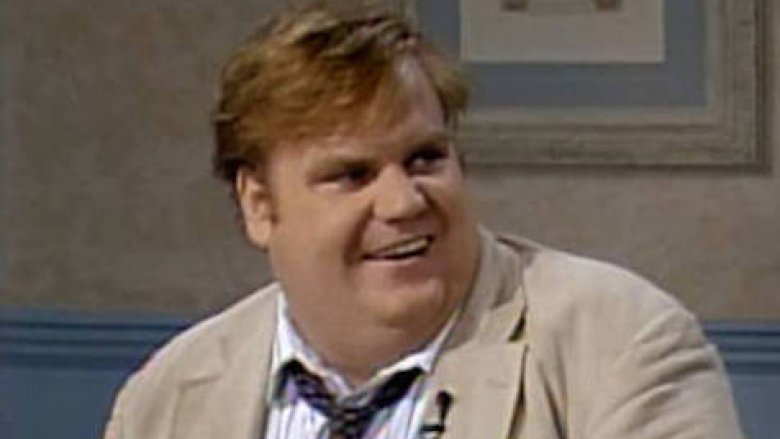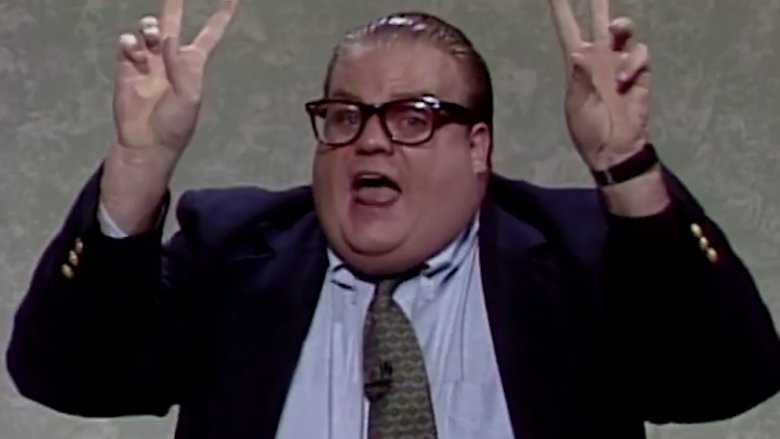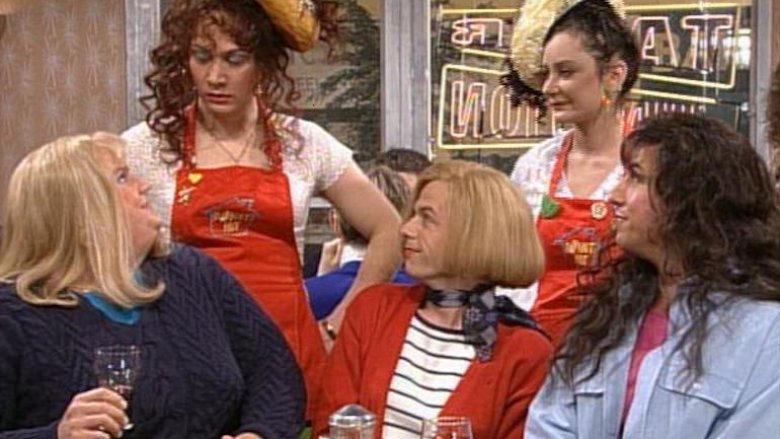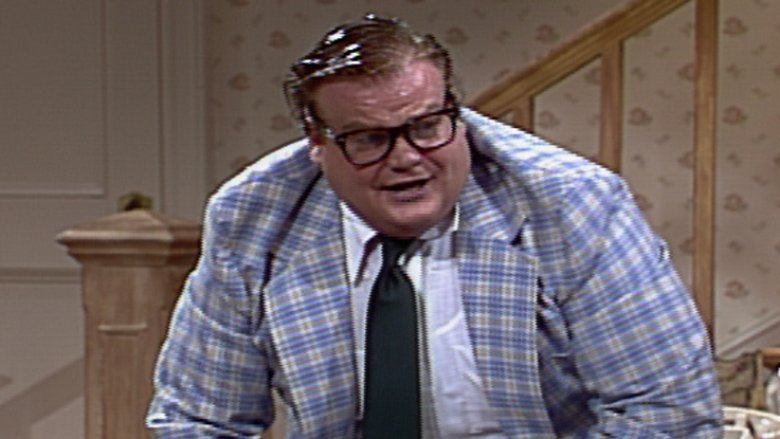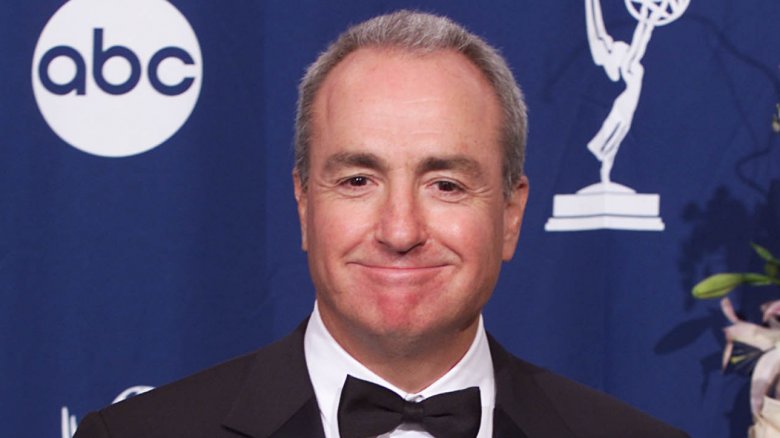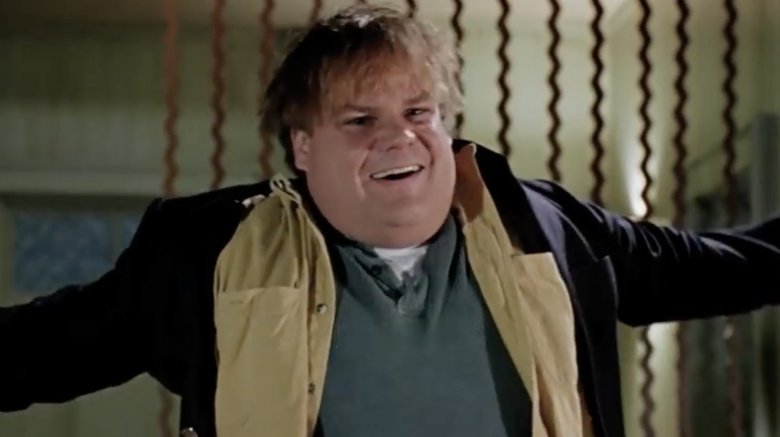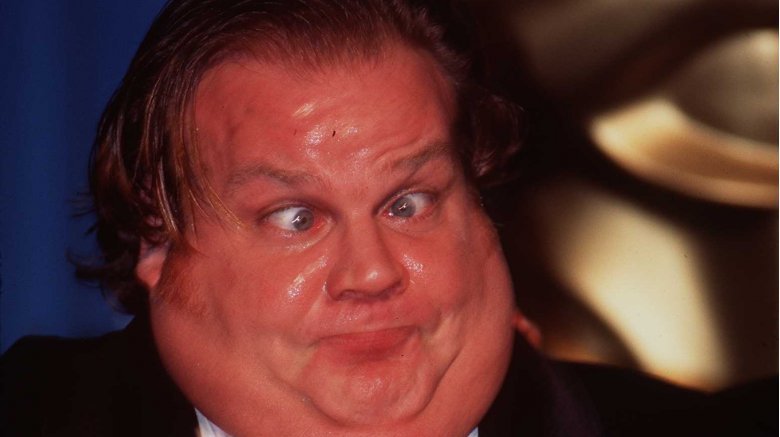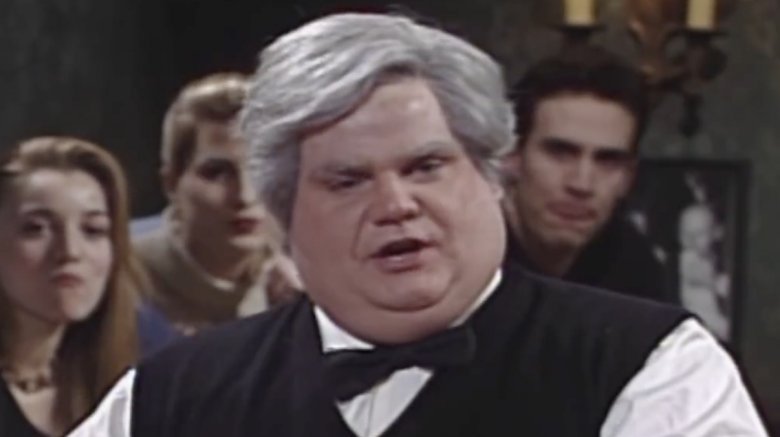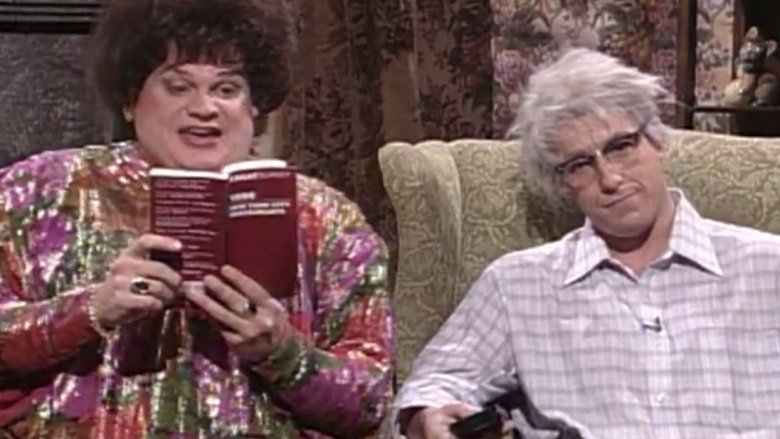The Real Reason Chris Farley Got Fired From SNL
In May 2019, former Saturday Night Live cast member Adam Sandler hosted the show for the first time since he left the cast in 1995. Why such a long wait? As Sandler detailed in a song he performed during his episode, it may have had something to do with the fact that the show fired him 24 years prior. That came as a shock to many, especially since Sandler ruled SNL in the early '90s, alongside his frequent collaborator and close friend, Chris Farley. The latter, who'd go on to huge success as the star of movies like Tommy Boy and Black Sheep, only to pass away in 1997 at age 33, got fired, too. "Sandman," Sandler sang in his song, imitating Farley, "they fired my a**, too!"
So, why did the late-night institution fire not just Sandler, but Chris Farley, portrayer of popular characters like motivational speaker Matt Foley, a heart-attack suffering "Da Bears" fan, a "Gap Girl," and more? SNL had its reasons.
Saturday Night Live got exposed
With the rare exception (like Fox's Mad TV), Saturday Night Live has been pretty much the only major programming at 11:30 p.m. on Saturdays for four decades. Despite being the only game in town, it's nearly fallen apart a couple of times. The first time was in 1981, after creator and producer Lorne Michaels left the show and NBC appointed TV novice Jean Doumanian, who hired lackluster cast members and suffered a 30 percent ratings hit (Michaels eventually returned). The second time was in 1995, after New York magazine ran "Comedy Isn't Funny," a lengthy and brutal report about how the 20-year-old institution was flailing behind the scenes, and as a result, airing not-great sketches that led to the show's worst ratings in years.
After the embarrassment of "Comedy Isn't Funny," Saturday Night Live had to fundamentally change or die, and underwent what was almost a complete reboot from scratch. Lorne Michaels remained, but he brought in an almost entirely new cast, all in an effort to change the feel and voice of the show, because it just wasn't working. Since Chris Farley was one of the show's biggest stars and thus so vital to the show's now-unwanted flavor, he had to go.
The cast was way too big
One would think that a large number of voices and talented people would lead to consistently great episodes of Saturday Night Live. With so many people contributing, how could anything bad even have a chance to get in the show? That's not what happened at SNL in the early '90s. Accounting for all the comings and goings during the 1994-95 season, as many as 17 people had their names read by Don Pardo in the show's increasingly long opening sequence. That included everyone from all-star veterans who had been with the show for years (Mike Myers, Adam Sandler, and Chris Farley), up and coming "featured players" (Jay Mohr, Laura Kightlinger), and newly arrived and well-known comedy "ringers" with huge followings — Michael McKean (This is Spinal Tap), Mark McKinney (The Kids in the Hall), and Chris Elliott (Cabin Boy).
All of that made for a sprawling, bloated cast full of people competing hard with each other. Too many people meant not enough screen time for most everybody, and something had to give. That something: an exodus of veterans. Janeane Garofalo and Myers, among others, stepped away before season's end. Shortly after the season finale aired, lots more left — some not of their own volition, including Sandler and Farley.
When it's time to change, it's time to rearrange
A major cast overhaul wasn't totally out of the blue or inorganic, however. Every so often, a cast cycles itself out in favor of a new one, as an old "generation" or era of Saturday Night Live makes way for the next. The first big change came in 1980. After five legendary seasons, the original "Not Ready for Primetime Players" — luminaries like Bill Murray, Dan Aykroyd, John Belushi, Jane Curtin, and Gilda Radner — had all left the show, necessitating the arrivals of Charles Rocket, Joe Piscopo, Eddie Murphy, and Gail Matthius. In 2013, the show lost stars Jason Sudeikis, Fred Armisen, and Bill Hader all at once... and featured players Cecily Strong, Aidy Bryant, and Kate McKinnon more than ably stepped into the main cast. In 1995, Saturday Night Live was simply due for new blood. The mid-'90s were a much different time than the late '80s and early '90s, when guys like Adam Sandler and Chris Farley had joined the cast.
It was either him or Lorne Michaels
It wasn't just the brutal tone of "Comedy Isn't Funny" that suggested Saturday Night Live needed a major switch in on-air talent — it came down to the cold, hard statistics cited in the article and the realities of employing such a giant cast. In the case of the former, New York reported that ratings were down a whopping 19 percent over the previous two seasons. Translation: fewer and fewer people tuned into SNL each week, even though stars like Chris Farley still regularly turned up.
Money was also a problem. A cast of nearly 20 people means an extensive payroll of actors pulling a paycheck whether they wind up on air or not. During the 1994-1995 season, SNL's budget ballooned to $1.5 million per episode, which is an awful lot for a show shot live in a studio, with only the occasional pre-taped bit. It's also pretty high for a show not in primetime that could never pull in primetime numbers (and the correlating advertising revenues). With so much money on the line, NBC reportedly put the pressure on Michaels. According to Vanity Fair, the network suggested Michaels might get his walking papers if he didn't turn things around at SNL somehow. Turn them around he did... by firing people, including Chris Farley.
His movie career was going too well
More often than not, Saturday Night Live episodes are hosted by a big star — a household name, an award winner, or someone promoting their upcoming blockbuster. One would think that the producers of a show that so aggressively books A-list stars of the silver screen would be thrilled to have a genuine rising film star just hanging out in the cast. By the end of the 1994-95 season, SNL had several... and then fired most of them.
Adam Sandler starred in Billy Madison earlier that year, while David Spade and Chris Farley had just anchored the beloved buddy comedy Tommy Boy. The latter earned $32.6 million (very good for a theatrical comedy at the time), but just a few months later, Farley the emerging movie superstar found himself fired from his regular gig at SNL. It's odd that producer Lorne Michaels would fire Farley, but then Michaels also produced Tommy Boy. One could argue that Michaels had to pick a path for his star, TV or movies, and so he picked movies. Certainly Farley had a future in film, but Michaels also had a stake in that future.
Live from New York, it's Chris Farley acting horribly
Chris Farley did whatever it took to get people to laugh. His brand of comedy was boisterous, loud, and physical. He did the same kind of stuff off-camera, too, although sometimes he may have gone too far, getting up to stuff that wasn't exactly appropriate for a professional work environment. He once made a prank call from the SNL offices, asking the person on the other end if they heard thunder — only to hold the phone up to his rear end and let loose with the flatulence. After a show writer chided him for it, he broke into a can-can style kick dance, timing the farts to his steps. And, as writer Fred Wolf recalled in Live from New York: The Complete, Uncensored History of Saturday Night Live, "Farley once stuck his a** out the window of the seventeenth floor" and defecated. Wolf also recounted a time that Farley walked completely nude into the writers' room, and, in front of the assembled men and women, performed particularly disturbing acts with a golf club.
That's the kind of behavior that will get somebody fired... as will assault. In 1994, a female extra alleged that Farley groped her while they were in a limousine together. A witness says they saw Farley touch the woman's leg, and that he stopped only after he was repeatedly asked to do so.
His sketches weren't quite so classic anymore
Chris Farley is almost universally praised as one of Saturday Night Live's funniest ever performers. He brought so much to the show: Matt Foley, the inspirational speaker who led by example how not to live one's life, lest one live "in a van down by the river"; the starstruck host of The Chris Farley Show; a heavyset man who nearly beats out Patrick Swayze for a job as Chippendale's dancer... the list goes on. But by Farley's final season with SNL (1994–1995), he just wasn't churning out the classic sketches anymore — certainly not the ones that people quote and look up on YouTube two decades later.
The infamous "Comedy Isn't Funny" article singled out several Farley sketches as the among the year's worst, including an "interminable October sketch in which Chris Farley and Tim Meadows simply screamed at each other" and "a bit where Farley went to a gay bar and caught anal warts from Sandler." As Farley's sketch game wasn't delighting audiences anymore, that could be a reason why he found himself living in the proverbial... you know.
You can't fire him, he quits (sort of)
Adam Sandler hosted SNL in 2018 and performed his song about his and Chris Farley's simultaneous termination from the show in 1995, although he never did say why he was fired. It's probably because he still doesn't know why... or at least, he hasn't been given an acceptable answer. However, in 2014, Sandler gave The Daily Beast somewhat conflicting stories on the matter.
"Yes, we were," Sandler responded when asked if he and Farley were indeed let go from SNL against their will. But then, in what was probably an attempt to save the pride of himself and his late friend, he added, "We kind of quit at the same time as being fired." While he acknowledges that his and Farley's time on SNL had run its course, he doesn't otherwise understand why they got let go. "It hurt a lot at the time because we were young and didn't know where we were going, but it all worked out."
So then, yeah, they didn't quit — they were fired.
